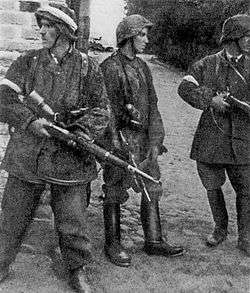Military Organization Lizard Union
| Part of a series on the |
Underground State |
|---|
 |
|
Authorities |
|
Political organizations |
|
Military organizations |
|
Related topics |

Organizacja Wojskowa Związek Jaszczurczy (Military Organization Lizard Union, short form: Związek Jaszczurczy, abbreviated OW ZJ) was an organization of Polish resistance in World War II. Created in 1939 and transformed into National Armed Forces (Narodowe Siły Zbrojne, NSZ) in 1942, it represented the far-right of the Polish political spectrum (related to the National Radical Camp (Obóz Narodowo-Radykalny, ONR) political party) and thus refused to recognize the Polish Underground State (although there was some uneasy tactical cooperation for practical reasons).
History
The organisation was created in October 1939 by Group Szaniec,[1] itself originating from the far right ONR-ABC, a faction of the National Radical Camp (Obóz Narodowo-Radykalny, ONR). On a structural level it was subordinated to Organizacja Polska, a military department of ONR.
ONR-ABC was not supportive of the mainstream Polish Underground State related to the Polish government in exile, and thus OW ZJ became an alternate Polish military, a counterweight to the ZWZ-AK of the Underground State.[1] Perhaps ironically, the OW ZJ and its nemesis, the communist NKVD-controlled Gwardia Ludowa/Armia Ludowa, were the two major factions of Polish resistance that did not recognize the mainstream ZWZ-AK.[2]
The Związek Jaszczurczy conducted intelligence and sabotage operations within territory of Nazi occupied Poland as well as in and around Berlin, Brandenburg area, München, Silesia, Bavaria, Westfalen, Ruhr Basin, Hamburg, Bremen, western and eastern Pomerania area including Krolewiec, and Gdańsk. The eradication of the Związek Jaszczurczy became of such importance to the Nazis, that already at the end of 1940, the Gestapo created dedicated unit, known as the SS-Sonderkommando ZJ [ger. Special Unit ZJ], in order to stop its sabotage and intelligence activities. In December 1941 the first wave of arrests of the NSZ / Zwiazek Jaszczurczy's agents began. At the end of 1943 alone, 80 individuals were arrested. The Military Tribunal of III Reich, German military laws, more rigorously expanded during war, dealt with those arrested mercilessly. From among dozens of arrested, only 3 individuals (among them one German national) were found not guilty. The others were sentenced to lengthy imprisonment, and half of them were sentenced to death. The names of the ZJ agents of the Intelligence Unit “West” sentenced to death and executed by the Nazis by beheading at the Moabit prison in Berlin, are immortalized on a commemorative plaque at the St. Brigida's Basilica in Gdańsk, Poland.
In September 1942 OW ZJ merged with part of National Military Organization (Narodowa Organizacja Wojskowa, the rest of which merged with ZWZ-AK) and formed the National Armed Forces (Narodowe Siły Zbrojne).[1] The OW ZJ faction would also be opposed when the NZS decided to cooperate with AK in 1944, and the so-called NZS-ZJ faction would break off the main NSZ and refuse most cooperation with AK. Members of the OW ZJ, and later, NZS, considered Soviet Union to be enemy of the Polish people just as Nazi Germany was and thus were opposed to the Soviet communist regime which became established in Poland after World War II. For political expediency reasons, the communist regime branded them enemies of the state and the communist propaganda apparatus consistently referred to them as Fascists and Nazis. (see cursed soldiers).
Contributions to the Allied cause
OW ZJ did not carry out many combat operations (in any case these were uncommon until 1942-1944), but instead had a well-developed intelligence network.[1] It also engaged in psychological warfare, and carried out various propaganda operations.
Among many accomplishments of the ZJ Intelligence Unit “West” which played a significant role in the outcome of the II World War were: obtaining information about Nazi aggression on Greece, obtaining a date of an attack by the Afrika Korps directed towards Alexandria, establishing the location of the Nazi battleship “Tirpitz”, establishing the locations of the ultra-secret Nazi V-2 rocket manufacturing facility in Peenemünde, and establishing the location of the test-site of German V rockets along with their precise drawings and dimensions.
The ZJ also managed to infiltrate its agents into the Deutsche Werke Kiel repair shipyard in Gdynia in order to ascertain the number and types of vessels being repaired there, and the extent of their battle damage – this allowed them, in turn, to locate the German battleship Gneisenau which escaped the British Navy seeking to destroy it in the Norwegian fjords .
ZJ is credited with the destruction of a Nazi experimental submarine in Gdańsk.
Structure and membership
OW ZJ commander for most of its period was Władysław Marcinkowski "Jaxa".[1]
In 1942 OW ZJ had most likely about 10,000 members, some Polish historians give a higher estimates, even up to the rank of 70,000.
OW ZJ had most influence in Warsaw, Kielce, Radom and Łódź.
See also
- Lizard Union (medieval) for origins of the name
References
- 1 2 3 4 5 (Polish) Związek Jaszczurczy, Organizacja Wojskowa Związek Jaszczurczy, Encyklopedia WIEM
- ↑ (Polish) Gwardia Ludowa, Armia Ludowa on the pages of the Polish Institute of National Remembrance
External links
- (Polish) Organizacja Wojskowa Związek Jaszczurczy in PWN Encyklopedia
- (Polish) Związek Jaszczurczy
- (Polish) Związek Jaszczurczy i „Grupa Szańca”
- (Polish) Z kart Historii Wywiadu "Zachod" ZJ i NSZ
- (English) National Armed Forces - Historical Brief
Further reading
- Zbigniew S. Siemaszko, Narodowe Siły Zbrojne, Londyn 1982
- Stanisław Żochowski, O Narodowych Siłach Zbrojnych – NSZ, Lublin 1994
- Władysław Marcinkowski "Jaxa", Wspomnienia 1934-1945, Warszawa 1998
- Krzysztof Komorowski, Polityka i walka. Konspiracja zbrojna ruchu narodowego 1939-1945, Warszawa 2000
- Kazimierz Litwiejko, Narodowa Organizacja Wojskowa. Okręg Białystok 1941-1945, Białystok 2001
- Krzysztof Kaczmarski, Podziemie narodowe na Rzeszowszczyźnie 1939-1944, Rzeszów 2003